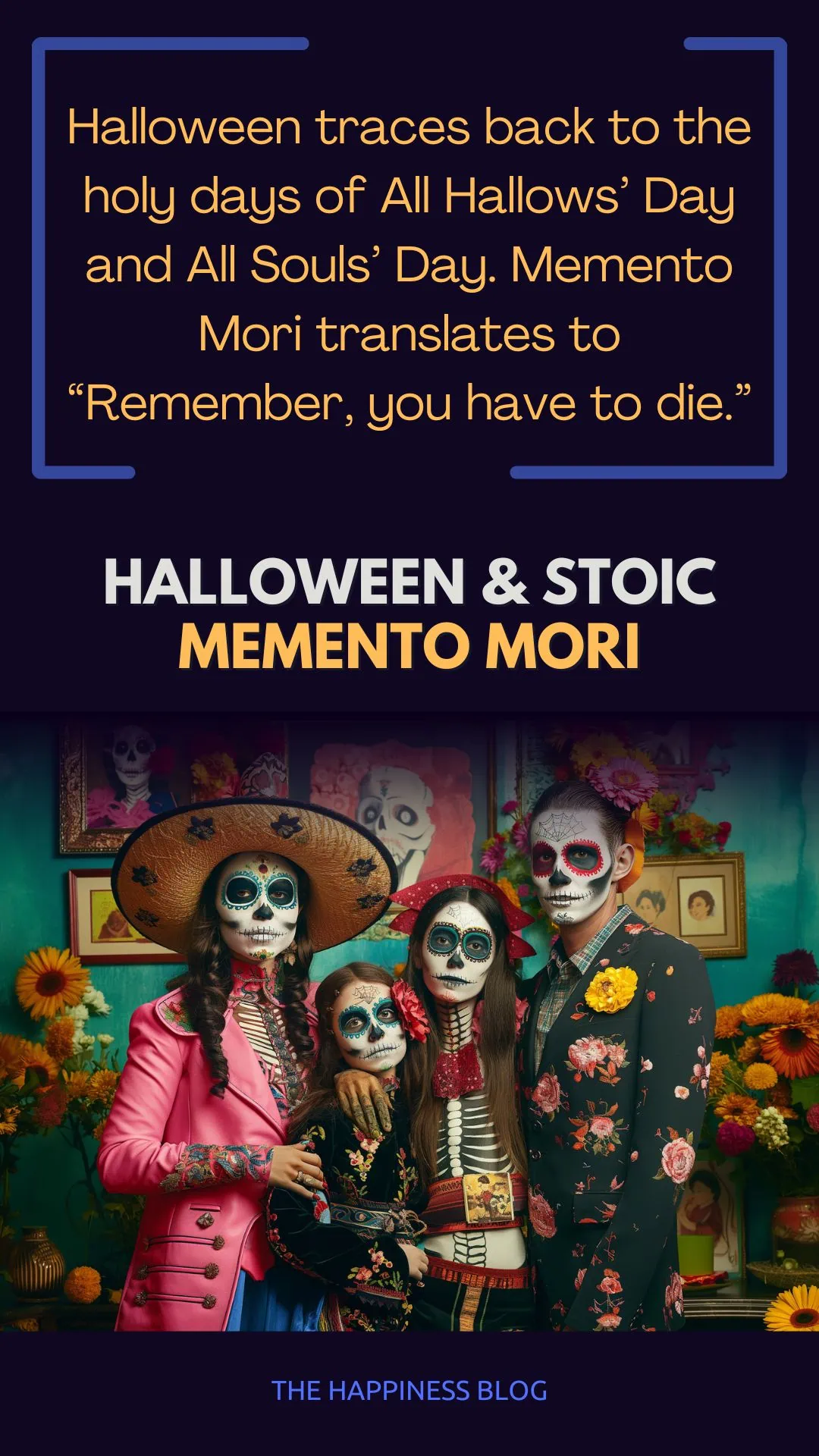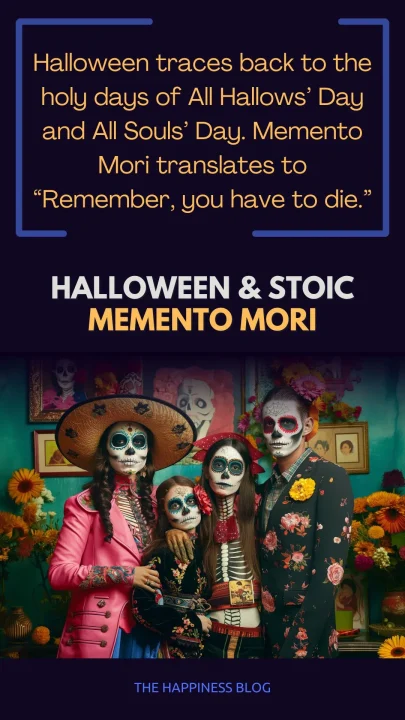Today's Thursday • 6 mins read
— By Dr. Sandip Roy.
Halloween is widely celebrated as a day of costumes, candy, and eerie fun. And, Memento Mori is a Stoic practice reminding us of our mortality.
How do these seemingly disparate traditions connect?
Halloween or All Saints Eve began to be observed around 1556 CE. Roughly heralding the arrival of winter, it is celebrated as a day when the graves may open and “the departed awake and speak to many.”
The true message behind Halloween is an ancient one: Memento mori.
How Halloween & Memento Mori Are Connected
At first glance, Halloween and Memento Mori might seem worlds apart—one is a festive celebration, and the other is a solemn reflection on mortality.
A deeper look, and we find that both serve as poignant reminders of life’s impermanence.
They share similar core messages. Both traditions remind us of the inevitability of human mortality, the shortness of life, and the urgency to do our best while we are here on Earth.
Both ask us to boldly confront the ultimate truth in life, cessation of life, and not shy away from it.
Once we accept our mortality, it can serve as a catalyst for enjoying life to the fullest, appreciating each moment, and living in a way that is true to our values.

Whether it’s dressing up as a skeleton for Halloween or contemplating a Memento Mori artwork, both practices serve as poignant reminders to cherish our time and make meaningful choices.
- The Inescapability of the End: Both Halloween and Memento Mori serve as stark reminders of the inescapable reality of our final rest.
- Living Life to the Fullest: These traditions encourage us to seize the day, making the most of each moment we have.
- Iconic Imagery: Halloween costumes and decorations frequently feature skeletons and images of the deceased, which are also traditional symbols used in Memento Mori.
- Christian Roots: Halloween originated from Christian beliefs and practices, specifically All Hallows’ Day and All Souls’ Day, aligning it with the spiritual undertones of Memento Mori.
- The Latin Reminder: Memento Mori translates to “Remember, you have to die,” serving as a verbal cue to reflect on our mortality.
- Playful yet Profound: While Halloween is often seen as a fun and lighthearted celebration, it also reminds us of life’s fleeting nature, much like Memento Mori.
The Origins of Halloween
Halloween traces its roots back to Christian traditions, particularly the holy days of All Hallows’ Day and All Souls’ Day.
These feasts had vigils that began the night before, setting the stage for what we now know as Halloween.
However, the holiday isn’t solely a Christian invention. It also draws from pre-Christian traditions, notably the Celtic festival of Samhain, which celebrated the end of the harvest season and the onset of winter.
This blend of Christian and pagan legacies has given Halloween its unique character.
Over time, Halloween has evolved, incorporating various elements from different sources.
Modern imagery, for instance, borrows from Christian eschatology, national customs, and even works of Gothic and horror literature.
Classic horror films have also played a role in shaping the holiday’s contemporary look and feel.

So, while Halloween may have started as a religious observance, it has grown into a multifaceted celebration influenced by a range of cultural and historical factors.
The Origins of Memento Mori
Memento Mori is a Latin phrase that translates to “Remember, you have to die.”
This Stoic practice serves as a poignant reminder of human mortality, urging us to live fully and mindfully. The Stoics used this concept to cultivate virtues like courage, wisdom, and self-control, emphasizing the importance of living a life true to one’s principles in the face of life’s uncertainties.
The concept has been deeply embedded in art and culture for centuries. It was particularly prevalent during the Middle Ages.
Tombs and monuments often featured carvings of skulls and skeletons, serving as visual reminders of life’s impermanence.
This artistic expression wasn’t limited to architecture; it permeated various art forms, including paintings, sculptures, and literature.
These works aimed to remind people of the fleeting nature of life and the randomness of our ultimate fate, encouraging them to live in a way that makes every moment count.
FAQs
1. What Are Some Traditional Halloween Decorations That Incorporate Memento Mori?
Skeletons, skulls, and tombstones are common sights during the holiday season of Halloween. These symbols serve a dual purpose: they add a spooky flair to the festivities, while also reminding us of our mortality.
So, when you hang that skeleton on your door or place a skull on your mantel, you are engaging with an age-old tradition that encourages reflection on life and the end of life.
2. How Can Memento Mori Be Used to Reflect on Life During Halloween?
Halloween can be more than just a night of costumes and candy; it can also be a time for introspection. Use the concept of Memento Mori to add a layer of mindfulness to the celebration.
For instance, while carving a pumpkin, consider its impermanence and how it mirrors human life.
Or take a moment to reflect on your life goals and personal growth when you see Halloween decorations that feature symbols of our transience. The idea is to use the holiday as a trigger for meaningful thought, turning it into a more enriching experience.
3. What Are Some Other Holidays or Events That Incorporate Memento Mori?
Memento Mori isn’t exclusive to Halloween. The Day of the Departed in Mexico is a holiday that directly engages with the concept of mortality. Ash Wednesday in the Christian tradition also serves as a reminder of human impermanence.
Even secular events like New Year’s Eve can incorporate Memento Mori, as the passing of the old year serves as a reminder of time’s relentless march. These occasions, like Halloween, use the concept to inspire reflection and purposeful living.
Final Words
Halloween and Memento Mori share a profound connection, both serving as reminders of our mortality and urging us to live fully.
As you celebrate this Halloween, consider its deeper meanings and how you can make it a more mindful event. As the Stoic philosopher Seneca said, “As is a tale, so is life: not how long it is, but how good it is, is what matters.”
Take this opportunity to reflect on making your life, however long or short, a good one.
√ Also Read: Memento Mori: Meaning, History, Art, Culture (Stoicism)
√ Please share it with someone if you found this helpful.
» You deserve happiness! Choosing therapy could be your best decision.
...
• Disclosure: Buying via our links earns us a small commission.

